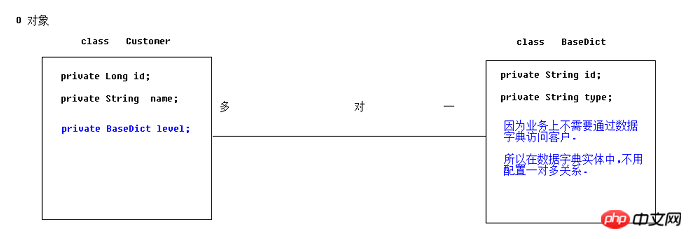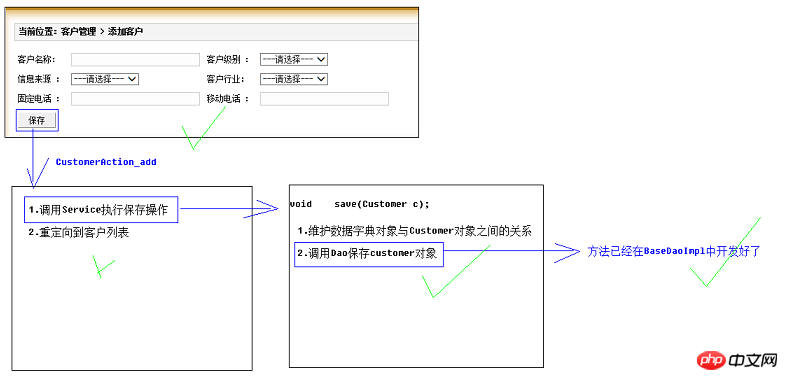 Java
Java
 javaLernprogramm
javaLernprogramm
 JAVAEE-Neukunden, Datenwörterbuch, Datei-Upload und Kundenerklärung ändern
JAVAEE-Neukunden, Datenwörterbuch, Datei-Upload und Kundenerklärung ändern
JAVAEE-Neukunden, Datenwörterbuch, Datei-Upload und Kundenerklärung ändern
Autor: kentpeng
Bitte geben Sie die Quelle für den Nachdruck an:
1. Neue Kunden
1. Datenwörterbuch
Wird für die Aufzählung A begrenzt verwendet Anzahl der Wörterbuchelemente im Projekt
(1) Die Beziehung zwischen dem Datenwörterbuch in der Tabelle und anderen Tabellen:


Anweisung zur Tabellenerstellung:
CREATE TABLE `base_dict` ( `dict_id` varchar(32) NOT NULL COMMENT '数据字典id(主键)', `dict_type_code` varchar(10) NOT NULL COMMENT '数据字典类别代码', `dict_type_name` varchar(64) NOT NULL COMMENT '数据字典类别名称', `dict_item_name` varchar(64) NOT NULL COMMENT '数据字典项目名称', `dict_item_code` varchar(10) DEFAULT NULL COMMENT '数据字典项目(可为空)', `dict_sort` int(10) DEFAULT NULL COMMENT '排序字段', `dict_enable` char(1) NOT NULL COMMENT '1:使用 0:停用', `dict_memo` varchar(64) DEFAULT NULL COMMENT '备注', PRIMARY KEY (`dict_id`) ) ENGINE=InnoDB DEFAULT CHARSET=utf8;
(2) Zuordnungsdateikonfiguration
Datenwörterbuchobjekt, auf das in der Kundenentität verwiesen wird:
//引用关联的数据字典对象private BaseDict cust_source; //客户来源 cust_source.dict_idprivate BaseDict cust_industry; //客户行业private BaseDict cust_level; //客户级别
Konfigurieren Sie das Datenwörterbuchobjekt in der Zuordnungsdatei:
<!-- 多对一 --><many-to-one name="cust_source" column="cust_source" class="BaseDict" ></many-to-one><many-to-one name="cust_industry" column="cust_industry" class="BaseDict" ></many-to-one><many-to-one name="cust_level" column="cust_level" class="BaseDict" ></many-to-one>
2. Verwenden Sie die Ajax-Technologie, um das Wörterbuch-Dropdown zu laden Auswahl auf der Seite
//使用ajax加载数据字典,生成select//参数1: 数据字典类型 (dict_type_code)//参数2: 将下拉选放入的标签id//参数3: 生成下拉选时,select标签的name属性值//参数4: 需要回显时,选中哪个optionfunction loadSelect(typecode,positionId,selectname,selectedId){//1 创建select对象,将name属性指定var $select = $("<select name="+selectname+" ></select>");//2 添加提示选项$select.append($("<option value='' >---请选择---</option>"));//3 使用jquery 的ajax 方法,访问后台Action$.post("${pageContext.request.contextPath}/BaseDictAction", { dict_type_code:typecode}, function(data){ //遍历//4 返回json数组对象,对其遍历 $.each( data, function(i, json){// 每次遍历创建一个option对象 var $option = $("<option value='"+json['dict_id']+"' >"+json["dict_item_name"]+"</option>");
if(json['dict_id'] == selectedId){//判断是否需要回显 ,如果需要使其被选中$option.attr("selected","selected");
}//并添加到select对象 $select.append($option);
});
},"json"); //5 将组装好的select对象放入页面指定位置$("#"+positionId).append($select);
}add.jsp
$(document).ready(function(){
loadSelect("006","level","cust_level.dict_id");
loadSelect("001","industry","cust_industry.dict_id");
loadSelect("009","source","cust_source.dict_id");
});</script>BaseDictAction:
public class BaseDictAction extends ActionSupport {private String dict_type_code; private BaseDictService baseDictService;
@Overridepublic String execute() throws Exception {//1 调用Service根据typecode获得数据字典对象listList<BaseDict> list = baseDictService.getListByTypeCode(dict_type_code);//2 将list转换为 json格式String json = JSONArray.fromObject(list).toString();//3 将json发送给浏览器ServletActionContext.getResponse().setContentType("application/json;charset=utf-8");
ServletActionContext.getResponse().getWriter().write(json);return null;//告诉struts2不需要进行结果处理 } public String getDict_type_code() {return dict_type_code;
}public void setDict_type_code(String dict_type_code) {this.dict_type_code = dict_type_code;
}public void setBaseDictService(BaseDictService baseDictService) {this.baseDictService = baseDictService;
}
}BaseDictServiceImpl:
public class BaseDictServiceImpl implements BaseDictService { private BaseDictDao bdd;
@Overridepublic List<BaseDict> getListByTypeCode(String dict_type_code) {return bdd.getListByTypeCode(dict_type_code);
}public void setBdd(BaseDictDao bdd) {this.bdd = bdd;
}
}BaseDictDaoImpl:
public class BaseDictDaoImpl extends BaseDaoImpl<BaseDict> implements BaseDictDao {
@Overridepublic List<BaseDict> getListByTypeCode(String dict_type_code) {//Criteria //创建离线查询对象DetachedCriteria dc = DetachedCriteria.forClass(BaseDict.class);//封装条件dc.add(Restrictions.eq("dict_type_code", dict_type_code));//执行查询List<BaseDict> list = (List<BaseDict>) getHibernateTemplate().findByCriteria(dc); return list;
}
}struts.xml
<!-- 数据字典Action --><action name="BaseDictAction" class="baseDictAction" method="execute" ></action>
applicationContext .xml
<bean name="baseDictAction" class="cn.xyp.web.action.BaseDictAction" scope="prototype" ><property name="baseDictService" ref="baseDictService" ></property></bean><bean name="baseDictService" class="cn.xyp.service.impl.BaseDictServiceImpl" ><property name="bdd" ref="baseDictDao" ></property></bean></bean><bean name="baseDictDao" class="cn.xyp.dao.impl.BaseDictDaoImpl" ><!-- 注入sessionFactory --><property name="sessionFactory" ref="sessionFactory" ></property></bean>
3. Neue Kunden analysieren und implementieren
Datei-Upload zu Kunden hinzufügen 
2. Hintergrundempfang (denken Sie daran, die Getset-Methode zu generieren)
<!-- 文件上传页面3个要求:1.表单必须post提交2.表单提交类型enctype.必须多段式.3.文件上传使用<input type="file" /> 组件
-->
<FORM id=form1 name=form1
action="${pageContext.request.contextPath }/CustomerAction_add"method="post" enctype="multipart/form-data" >Verwendung:
//上传的文件会自动封装到File对象//在后台提供一个与前台input type=file组件 name相同的属性private File photo;//在提交键名后加上固定后缀FileName,文件名称会自动封装到属性中private String photoFileName;//在提交键名后加上固定后缀ContentType,文件MIME类型会自动封装到属性中 private String photoContentType;
public String add() throws Exception {if(photo!=null){
System.out.println("文件名称:"+photoFileName);
System.out.println("文件类型:"+photoContentType);//将上传文件保存到指定位置photo.renameTo(new File("E:/upload/haha.jpg"));
}Das obige ist der detaillierte Inhalt vonJAVAEE-Neukunden, Datenwörterbuch, Datei-Upload und Kundenerklärung ändern. Für weitere Informationen folgen Sie bitte anderen verwandten Artikeln auf der PHP chinesischen Website!

Heiße KI -Werkzeuge

Undresser.AI Undress
KI-gestützte App zum Erstellen realistischer Aktfotos

AI Clothes Remover
Online-KI-Tool zum Entfernen von Kleidung aus Fotos.

Undress AI Tool
Ausziehbilder kostenlos

Clothoff.io
KI-Kleiderentferner

Video Face Swap
Tauschen Sie Gesichter in jedem Video mühelos mit unserem völlig kostenlosen KI-Gesichtstausch-Tool aus!

Heißer Artikel

Heiße Werkzeuge

Notepad++7.3.1
Einfach zu bedienender und kostenloser Code-Editor

SublimeText3 chinesische Version
Chinesische Version, sehr einfach zu bedienen

Senden Sie Studio 13.0.1
Leistungsstarke integrierte PHP-Entwicklungsumgebung

Dreamweaver CS6
Visuelle Webentwicklungstools

SublimeText3 Mac-Version
Codebearbeitungssoftware auf Gottesniveau (SublimeText3)

Heiße Themen
 1391
1391
 52
52
 Stellen Sie JavaEE-Anwendungen mithilfe von Docker-Containern bereit
Jun 05, 2024 pm 08:29 PM
Stellen Sie JavaEE-Anwendungen mithilfe von Docker-Containern bereit
Jun 05, 2024 pm 08:29 PM
Stellen Sie Java EE-Anwendungen mithilfe von Docker-Containern bereit: Erstellen Sie eine Docker-Datei, um das Image zu definieren, erstellen Sie das Image, führen Sie den Container aus, ordnen Sie den Port zu und greifen Sie dann im Browser auf die Anwendung zu. Beispiel für eine JavaEE-Anwendung: Die REST-API interagiert mit der Datenbank und ist nach der Bereitstellung über Docker auf localhost zugänglich.
 Copilot-Integration: Zusammenarbeit im SharePoint- und Dynamics 365-Kundenservice
Aug 03, 2023 pm 09:21 PM
Copilot-Integration: Zusammenarbeit im SharePoint- und Dynamics 365-Kundenservice
Aug 03, 2023 pm 09:21 PM
Microsoft hat heute eine frühe Vorschau der SharePoint-Integration mit Copilot in Dynamics 365 Customer Service angekündigt. Durch diese Integration erhalten Kundendienstmitarbeiter Zugriff auf ein breiteres Spektrum an Wissensquellen, was zu einer höheren Produktivität und verbesserten Kundeninteraktionen führt. Derzeit nutzt Copilot im Dynamics365 Customer Service eine interne Wissensdatenbank, um Kundendienstmitarbeitern Anleitung zu geben. Durch das Vorschlagen von Chat- und Entwurfs-E-Mail-Inhalten ist Copilot zu einem wichtigen Tool zur Steigerung der Produktivität Ihres Kundenservice-Teams geworden. Kundenfeedback zeigt jedoch, dass das Tool Wissen aus externen Quellen wie SharePoint nutzen muss. SharePoint Collaborative Driving Integration Als Reaktion auf dieses Feedback
 Neue statische Methode der DateTime-Klasse in PHP8.1
Jul 08, 2023 pm 12:42 PM
Neue statische Methode der DateTime-Klasse in PHP8.1
Jul 08, 2023 pm 12:42 PM
Die neue statische Methode der DateTime-Klasse in PHP8.1 Die PHP8.1-Version führt einige leistungsstarke Features und Funktionen ein. Eines der auffälligsten Updates ist die statische Methode der DateTime-Klasse. Die DateTime-Klasse ist ein wichtiges Werkzeug zur Verarbeitung von Datums- und Uhrzeitangaben in PHP. Sie bietet viele praktische Methoden zum Betreiben und Verarbeiten von Datums- und Uhrzeitdaten. Werfen wir einen Blick auf einige der neuen statischen Methoden der DateTime-Klasse in PHP8.1 und ihre Anwendungsbeispiele. DateTime::cr
 Der Unterschied zwischen Java und Javaee
Nov 02, 2023 am 10:50 AM
Der Unterschied zwischen Java und Javaee
Nov 02, 2023 am 10:50 AM
Java und Javaee werden definiert und verwendet, Komponenten und Funktionen, Plattformen und Umgebungen, Anwendungsumfang und Entwicklungsmodelle usw. Ausführliche Einführung: 1. Definition und Zweck: Java ist eine objektorientierte Programmiersprache, die 1995 von Sun Microsystems eingeführt wurde. Java zeichnet sich durch plattformübergreifende Funktionalität, Portabilität, Sicherheit und Einfachheit aus und wird häufig zur Entwicklung verschiedener Anwendungen verwendet Java EE ist eine Erweiterung der Java-Plattform auf Unternehmensebene, die für die Entwicklung und Bereitstellung umfangreicher, skalierbarer und zuverlässiger Anwendungen auf Unternehmensebene usw. konzipiert ist.
 Linux-Benutzerverwaltung: Offenlegung neuer Benutzervorgänge
Feb 24, 2024 pm 11:03 PM
Linux-Benutzerverwaltung: Offenlegung neuer Benutzervorgänge
Feb 24, 2024 pm 11:03 PM
In Linux-Systemen ist das Hinzufügen neuer Benutzer ein wichtiger Teil der Verwaltung von Systemberechtigungen und Sicherheit. In diesem Artikel werden die spezifischen Methoden zum Hinzufügen von Benutzern im Linux-Betriebssystem erläutert, einschließlich spezifischer Codebeispiele und Schrittanweisungen, um den Lesern zu helfen, die Fähigkeiten zum Hinzufügen von Benutzern schnell zu erlernen. 1. Verwenden Sie den Befehl „adduser“, um einen Benutzer hinzuzufügen. Der Befehl „adduser“ ist das bevorzugte Tool zum Hinzufügen von Benutzern in Debian und Ubuntu. Dieser Befehl ruft den Befehl „useradd“ auf und legt einige Standardwerte fest, was den Vorgang zum Hinzufügen von Benutzern vereinfacht. Um ein hinzuzufügen
 Kompatibilitätsprobleme zwischen JavaEE und Container-Technologie
Jun 03, 2024 pm 05:11 PM
Kompatibilitätsprobleme zwischen JavaEE und Container-Technologie
Jun 03, 2024 pm 05:11 PM
Bei der Verwendung von Java EE-Containeranwendungen können Kompatibilitätsprobleme wie Sitzungsstatusverwaltung, Abhängigkeitsinjektion, Ressourcenpooling und Sicherheit auftreten. Zu den Lösungen für diese Probleme gehören die Verwendung von externem Sitzungsspeicher, die Konfiguration von JNDI, die Verwaltung von Ressourcenpools und die Konfiguration der Sicherheit, um sicherzustellen, dass Java EE-Anwendungen nahtlos in die Containertechnologie integriert werden und die Vorteile der Containerisierung nutzen.
 iPhone 16 Pro-Renderings enthüllt: neue Kamerataste
Mar 12, 2024 pm 12:40 PM
iPhone 16 Pro-Renderings enthüllt: neue Kamerataste
Mar 12, 2024 pm 12:40 PM
Ausländische Medien haben kürzlich CAD-Rendering-Bilder des iPhone 16 Pro veröffentlicht, die die Designdetails und Größenspezifikationen des neuen Modells zeigen. Den durchgesickerten Designzeichnungen zufolge nutzt das iPhone 16 Pro weiterhin das Smart-Island-Design der Vorgängergeneration und behält das Integrationsschema des hinteren Kameramoduls bei. Gleichzeitig besteht der Mittelrahmen weiterhin aus hochwertigem Titanmaterial . Es ist erwähnenswert, dass dieses Telefon zwei bedeutende Verbesserungen mit sich gebracht hat: Erstens hat das iPhone 16 Pro in Bezug auf die Bildschirmanzeige die Rahmenbreite weiter reduziert und so das Bildschirm-zu-Gehäuse-Verhältnis erhöht 6,1 Zoll des iPhone 15 Pro auf 6,3 Zoll. Zweitens hat Apple es unterhalb des Power-Buttons auf der rechten Rumpfseite mit einem neuen physischen Kamera-Button ausgestattet, den Nutzer nutzen können
 Muss der Douyin-E-Commerce während des chinesischen Neujahrs Kunden empfangen? Kundendienstregeln für kleine Geschäfte während des chinesischen Neujahrs
Mar 07, 2024 pm 06:50 PM
Muss der Douyin-E-Commerce während des chinesischen Neujahrs Kunden empfangen? Kundendienstregeln für kleine Geschäfte während des chinesischen Neujahrs
Mar 07, 2024 pm 06:50 PM
Mit der boomenden Entwicklung von Social-Media-Plattformen ist Douyin-E-Commerce für viele Händler zu einer bevorzugten Wahl geworden. Allerdings gab es einige Kontroversen und Diskussionen rund um die Frage, ob Douyin-E-Commerce-Unternehmen während des chinesischen Neujahrs einen Kundenservice bieten müssen. 1. Muss der Douyin-E-Commerce während des chinesischen Neujahrs Kunden empfangen? Ein wichtiges traditionelles chinesisches Fest ist Neujahr. Zu dieser Zeit gehen die Menschen normalerweise nach Hause, um sich mit ihren Familien zu treffen und eine glückliche und entspannte Zeit zu genießen. Für Douyin-E-Commerce-Praktiker ist die Frage, ob sie während des chinesischen Neujahrs Kunden empfangen müssen, eine Frage, die sorgfältig abgewogen werden muss. Einerseits ist das chinesische Neujahr für Händler die beste Zeit, um den Verkauf anzukurbeln, da viele Menschen in dieser Zeit einen höheren Konsumbedarf haben. Daher muss sorgfältig abgewogen werden, ob Sie während des chinesischen Neujahrs Kunden empfangen müssen. Einerseits kann der Empfang von Kunden Umsätze für das Unternehmen bringen



